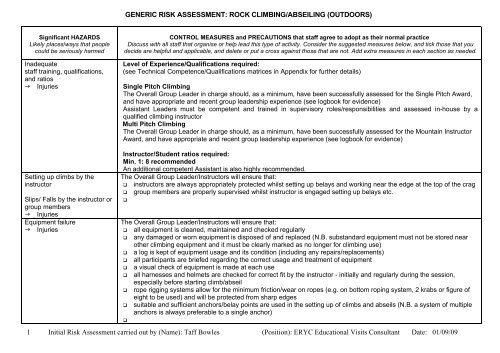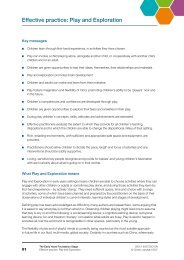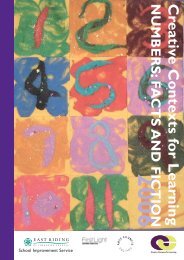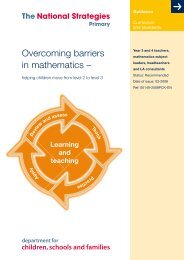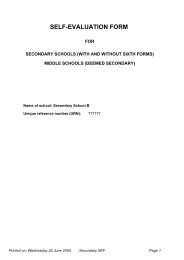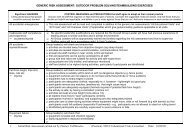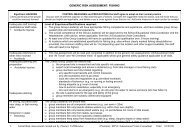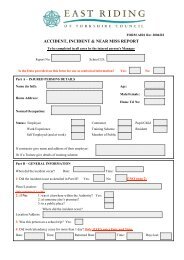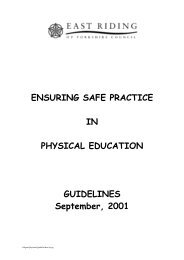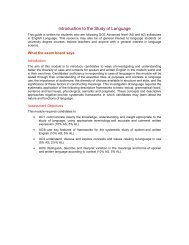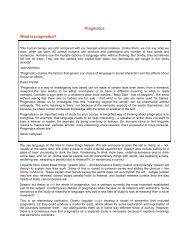generic risk assessment: rock climbing/abseiling - eRiding
generic risk assessment: rock climbing/abseiling - eRiding
generic risk assessment: rock climbing/abseiling - eRiding
Create successful ePaper yourself
Turn your PDF publications into a flip-book with our unique Google optimized e-Paper software.
GENERIC RISK ASSESSMENT: ROCK CLIMBING/ABSEILING (OUTDOORS)Significant HAZARDSLikely places/ways that peoplecould be seriously harmedInadequatestaff training, qualifications,and ratios InjuriesCONTROL MEASURES and PRECAUTIONS that staff agree to adopt as their normal practiceDiscuss with all staff that organise or help lead this type of activity. Consider the suggested measures below, and tick those that youdecide are helpful and applicable, and delete or put a cross against those that are not. Add extra measures in each section as needed.Level of Experience/Qualifications required:(see Technical Competence/Qualifications matrices in Appendix for further details)Single Pitch ClimbingThe Overall Group Leader in charge should, as a minimum, have been successfully assessed for the Single Pitch Award,and have appropriate and recent group leadership experience (see logbook for evidence)Assistant Leaders must be competent and trained in supervisory roles/responsibilities and assessed in-house by aqualified <strong>climbing</strong> instructorMulti Pitch ClimbingThe Overall Group Leader in charge should, as a minimum, have been successfully assessed for the Mountain InstructorAward, and have appropriate and recent group leadership experience (see logbook for evidence)Setting up climbs by theinstructorSlips/ Falls by the instructor orgroup members InjuriesEquipment failure InjuriesInstructor/Student ratios required:Min. 1: 8 recommendedAn additional competent Assistant is also highly recommended.The Overall Group Leader/Instructors will ensure that: instructors are always appropriately protected whilst setting up belays and working near the edge at the top of the crag group members are properly supervised whilst instructor is engaged setting up belays etc.The Overall Group Leader/Instructors will ensure that: all equipment is cleaned, maintained and checked regularly any damaged or worn equipment is disposed of and replaced (N.B. substandard equipment must not be stored nearother <strong>climbing</strong> equipment and it must be clearly marked as no longer for <strong>climbing</strong> use) a log is kept of equipment usage and its condition (including any repairs/replacements) all participants are briefed regarding the correct usage and treatment of equipment a visual check of equipment is made at each use all harnesses and helmets are checked for correct fit by the instructor - initially and regularly during the session,especially before starting climb/abseil rope rigging systems allow for the minimum friction/wear on ropes (e.g. on bottom roping system, 2 krabs or figure ofeight to be used) and will be protected from sharp edges suitable and sufficient anchors/belay points are used in the setting up of climbs and abseils (N.B. a system of multipleanchors is always preferable to a single anchor)1 Initial Risk Assessment carried out by (Name): Taff Bowles (Position): ERYC Educational Visits Consultant Date: 01/09/09
GENERIC RISK ASSESSMENT: ROCK CLIMBING/ABSEILING (OUTDOORS)Significant HAZARDSLikely places/ways that peoplecould be seriously harmedBouldering(in addition to above)Slips/ Falls InjuriesCONTROL MEASURES and PRECAUTIONS that staff agree to adopt as their normal practiceDiscuss with all staff that organise or help lead this type of activity. Consider the suggested measures below, and tick those that youdecide are helpful and applicable, and delete or put a cross against those that are not. Add extra measures in each section as needed.The Overall Group Leader/Instructors will ensure that: group members are briefed to climb below a set max. height group members are trained how to “spot” climbers climbers check that nobody is below before jumping off set challenges are within the abilities of the group a site is chosen where there are no significant hazards (e.g. protruding sharp <strong>rock</strong>s or steep slopes) below the <strong>rock</strong>sused for boulderingBelaying/ AbseilingRope burn InjuriesBottom or top roped climbs/abseilsSlips/ Falls (whilst<strong>climbing</strong>/<strong>abseiling</strong>) InjuriesThe Overall Group Leader/Instructors will ensure that: all participants are briefed how to belay correctly and to lower climbers slowly all participants are briefed to abseil slowlyThe Overall Group Leader/Instructors will ensure that: group members are informed about and follow <strong>climbing</strong> procedures and calls group members are briefed initially regarding safe and unsafe areas at the top and bottom of the crag, and any no-goareas particularly hazardous areas will be roped off all routes can be effectively and safely supervised and monitored by Leaders only appropriately qualified/competent leaders set up and change the belays belayers are trained and assessed as competent and reliable before allowing them to belay without directsupervision belayers are reminded at frequent intervals to stay focussed and to concentrate on their own climber’s needs appropriate belaying systems/devices are used, according to the age/sizes/weights and competences of the groupmembers backup belayers are used if appropriate the belayers are supervised and monitored throughout by qualified/experienced Leaders belayers are briefed to lower climbers at a slow, even pace, with particular care given near ground level harnesses are securely fastened and checked by the Instructor/Assistant Leaders at the start of the <strong>climbing</strong> session,and after any rest period where harness may be removed/altered karabiners are closed/locked/checked before each and every climb (N.B. use of Belay Master type system ensuresfailsafe locking) helmets are worn at all times ropes are correctly tied/attached into harnesses (and checked by Leaders) using the method recommended by theharness manufacturers (N.B. tying in, usually with a rethreaded figure of eight and stopper knot, is normally considered2 Initial Risk Assessment carried out by (Name): Taff Bowles (Position): ERYC Educational Visits Consultant Date: 01/09/09
GENERIC RISK ASSESSMENT: ROCK CLIMBING/ABSEILING (OUTDOORS)Significant HAZARDSLikely places/ways that peoplecould be seriously harmedCONTROL MEASURES and PRECAUTIONS that staff agree to adopt as their normal practiceDiscuss with all staff that organise or help lead this type of activity. Consider the suggested measures below, and tick those that youdecide are helpful and applicable, and delete or put a cross against those that are not. Add extra measures in each section as needed.Abseils or climbsSlips/Falls (whilst onascent/descent approachpaths and from top to base ofcrag) InjuriesAt base of climbs or on climbsFalling <strong>rock</strong>s InjuriesLead <strong>climbing</strong>(in addition to above)Slips/ Fallspreferable to the use of karabiner attachment)group members are wearing suitable footwear with a good gripgroup members are briefed to dry/clean footwear before <strong>climbing</strong>a safety rope is always used on abseil sessions in addition to the abseil ropeparticipants are attached to the safety rope before approaching the edge of the craga handline/safety rope is used to protect the approachthe abseil rope is always checked to ensure that it reaches the groundseparate anchors are used for the abseil rope and the safety ropeinstructors are always able to free themselves from their belay system to help with emergenciescorrect techniques for <strong>abseiling</strong> and being lowered from a climb are taughtfor individuals at <strong>risk</strong> of falling out of their harness if they invert (e.g. the very thin or the very fat), a chest harness willalso be usedThe Overall Group Leader/Instructors will ensure that: <strong>climbing</strong> sites are chosen carefully, with safe ascent/descents paths, and safe, clearly marked routes between top andbottom of the crag hazardous areas are roped off handrails/safety lines are provided over awkward groundThe Overall Group Leader/Instructors will ensure that: <strong>climbing</strong> sites are chosen carefully, with no obvious loose <strong>rock</strong>s on or above the climbs the area at the top of the climbs is inspected and cleared of any hazardous loose <strong>rock</strong> participants are briefed regarding the hazard and told to move carefully especially on and at the top of climbs participants are briefed how to alert others if a loose <strong>rock</strong> is dislodged (shout “Below!” etc.) participants are briefed how to take avoiding action if below any group members (apart from belayers) who remain at the base of a <strong>rock</strong> face are instructed to wait at safe distancefrom the <strong>rock</strong> group members wear helmets at all times ropes are kept tidy and away from possible snagsThe Overall Group Leader/Instructors will ensure that: climbers are given an appropriate staged progression when learning to lead (with close instructor supervision, at leastinitially) bolts/belays are placed at appropriate levels and intervals3 Initial Risk Assessment carried out by (Name): Taff Bowles (Position): ERYC Educational Visits Consultant Date: 01/09/09
GENERIC RISK ASSESSMENT: ROCK CLIMBING/ABSEILING (OUTDOORS)Significant HAZARDSLikely places/ways that peoplecould be seriously harmedCONTROL MEASURES and PRECAUTIONS that staff agree to adopt as their normal practiceDiscuss with all staff that organise or help lead this type of activity. Consider the suggested measures below, and tick those that youdecide are helpful and applicable, and delete or put a cross against those that are not. Add extra measures in each section as needed. Injuries climbers are trained in the correct use of extenders and clipping in belayers are trained, and competent in giving correct amount of rope slack/tension for lead climber, and in handling afallAbseilingHair/fingers trapped in abseildevice Stuck/ InjuriesThe Overall Group Leader/Instructors will ensure that: participants are briefed on correct hand position the belay device is positioned at an extended distance from the abseiler, using a sling long hair and loose clothing is tied back so as not to be entangled in abseil device participants wear suitable gloves participants are asked to remove jewellery the abseil ropes are releasable the ropes are rigged to enable the instructor to see the abseiler for the full length of the abseilAll accidents and emergencies The Overall Group Leader/Instructors will ensure that: instructors are trained in rescue techniques instructors have appropriate first aid training and qualifications instructors are equipped to deal with accidents and emergencies (e.g. first aid kit, survival bag, knife, prussik loopsetc.) there are appropriate means of contacting help in an emergency (e.g. mobile phone)Inadequate planning This <strong>risk</strong> <strong>assessment</strong> will be read and completed in addition to the <strong>generic</strong> <strong>risk</strong> <strong>assessment</strong>s “All Educational Visits”and “All Travel” and “All Overseas Visits” (if applicable) which give general safety guidance applicable to all visits.Additional hazards? Additional precautions?4 Initial Risk Assessment carried out by (Name): Taff Bowles (Position): ERYC Educational Visits Consultant Date: 01/09/09
GENERIC RISK ASSESSMENT: ROCK CLIMBING/ABSEILING (OUTDOORS)Staff Agreement: “I have read and understood this <strong>risk</strong> <strong>assessment</strong>, and I agree to adopt as standard the control measures and precautions stated above”Staff name(continue list overleaf if required)1.2.3.4.5.6.7.8.9.10.11.12.13.14.15.16.17.18.19.20.Job title Sept 2009 – 10(Initials/date)Sept 2010 – 11(Initials/date)Sept 2011 – 12(Initials/date)Sept 2012 – 13(Initials/date)Sept 2013 – 14(Initials/date)Generic Risk Assessments• Purpose - to encourage staff to identify likely hazards, agree good practice, and apply consistent standards. Follow suggested procedure below (or similar):• Select and print off - all relevant and helpful forms (according to the type of visits and activities normally organised during the year) – others (e.g. that apply to one-off visits) can be added later if required.• How many? - one set of forms for small staff teams - or one set per department for large staff teams.• Complete draft forms - initially by one or two staff with appropriate experience;• Staff meeting 1 - introduce and leave draft forms in a file for all relevant staff (i.e. those who organise or help lead such visits) to inspect and consider over a short period (e.g. a week).• Staff meeting 2 - discuss, amend, and agree main hazards and standard practice with all relevant staff (add names and initials in table below to indicate acceptance).• Staff members who cannot agree with the general consensus should complete their own <strong>risk</strong> <strong>assessment</strong>, but this must be agreed and approved by the Headteacher/Manager.• Check and approve - by line manager/head of dept and/or visits coordinator (add approval signatures in table below).• Store - in a marked file in a clearly known and accessible place (e.g. staff room or dept office).• How often? - forms that apply to all visits (e.g. “All Educational Visits”) or to regular/frequent visits (e.g. “Visits to Museums” ) should be completed once, then reviewed, amended, signed and dated annually.• Additional forms - that apply to occasional/one-off visits (e.g. “Overseas Visits”) can be completed when required – these should be reviewed, amended, signed and dated whenever such visits are planned.• Keep familiar- with the agreed practice, and refer to forms as a reminder before visits if necessary (especially for activities that are less frequent or familiar to staff).• New leaders and volunteers - should be asked to read all relevant forms and add their signed agreement before assisting with the organisation or leadership of a visit.• Review and amend - by all relevant staff annually (or more often if necessary), and immediately if new hazards are identified or new precautions deemed necessary.• Stop - this type of visit/activity if the level of <strong>risk</strong> is considered unmanageable and unacceptable.• Flexibility - may be acceptable on occasion, if staff can reasonably justify their actions.• Specific Visit Risk Assessment - is also required for each visit to address any extra issues relevant to the specific site/group/activities involved5 Initial Risk Assessment carried out by (Name): Taff Bowles (Position): ERYC Educational Visits Consultant Date: 01/09/09


